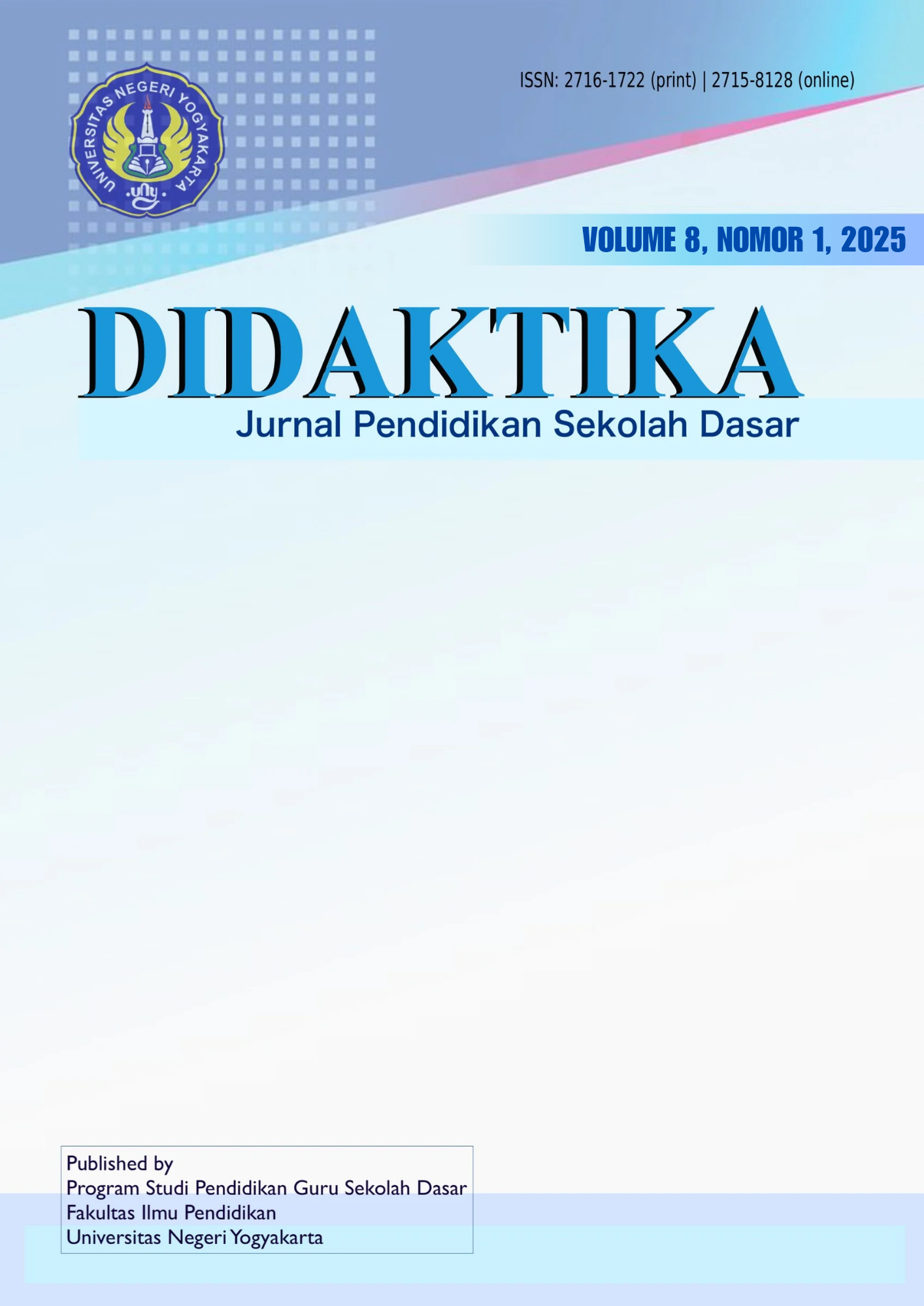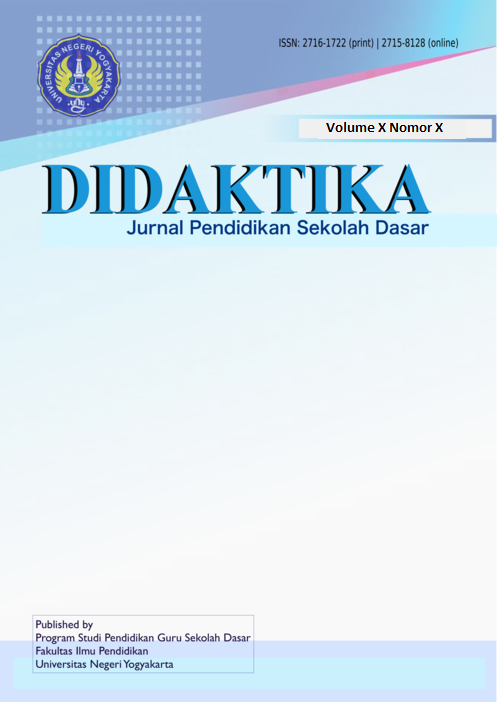Development of Visual Literacy Assessment Instrument for Elementary School Students
Abstract
The development of visual literacy skills has become increasingly important in the digital age, especially for elementary school students who are constantly exposed to various forms of visual media. However, there is a lack of validated assessment tools specifically designed to measure visual literacy abilities among elementary students. This study aimed to develop and validate a comprehensive visual literacy assessment tool for fifth-grade students. The development process followed a systematic approach, including a literature review, expert validation, pilot testing, and psychometric analysis. The research involved 200 fifth-grade students from Jatiyoso District, Karanganyar Regency. Content validity was established through expert review, while construct validity was examined using Exploratory Factor Analysis (EFA). The instrument demonstrated excellent internal consistency with a Cronbach's alpha of 0.930 and strong test-retest reliability. The final tool consists of 10 items distributed across four domains: reading visual objects, understanding meanings from visual objects, evaluating visual objects, and creating visual objects. Factor analysis revealed a four-factor solution explaining significant variance in visual literacy skills. The tool provides educators and researchers with a reliable means for assessing visual literacy skills and can inform instructional decisions in elementary education. This study advances the field by offering a validated measurement instrument that fills the gap in visual literacy assessment for young learners.
References
Agustina, E., & Supahar. (2021). Development of Visual Literacy Test Instrument on High School Physics Material. 528(Icriems 2020), 505–510.
Aisami, R. S. (2015). Learning styles and visual literacy for learning and performance. Procedia - Social and Behavioral Sciences, 176, 538–545. https://doi.org/10.1016/j.sbspro.2015.01.508
Amin, A. M., & Adiansyah, R. (2023). The contribution of communication skills and digital literacy to students’ critical thinking skills. Formatif: Jurnal Ilmiah Pendidikan MIPA, 13 (2), 279-294.
Anderson, J., & Macleroy, V. (2016). Multilingual Digital Storytelling: Engaging creatively and critically with literacy. Taylor & Francis. https://books.google.co.id/books?id=12GpCwAAQBAJ
Arneson, J. B., & Offerdahl, E. G. (2018). Visual Literacy in Bloom: Using Bloom’s Taxonomy to Support Visual Learning Skills. CBE Life Sciences Education, 17(1). https://doi.org/10.1187/cbe.17-08-0178
Avgerinou, M. D., & Pettersson, R. (2011). Toward a Cohesive Theory of Visual Literacy. Journal of Visual Literacy, 30, 1–19. https://api.semanticscholar.org/CorpusID:57730551
Avgerinou, M. D., & Pettersson, R. (2016). Toward a Cohesive Theory of Visual Literacy Toward a Cohesive Theory of Visual Literacy. 6529(March). https://doi.org/10.1080/23796529.2011.11674687
Bamford, A. (2003). The Visual Literacy White Paper. Adobe Systems. https://api.semanticscholar.org/CorpusID:102337880
Bronkhorst, H., Roorda, G., Suhre, C., & Goedhart, M. (2021). Student Development in Logical Reasoning : Results of an Intervention Guiding Students Through Different Modes of Visual and Formal Representation. Canadian Journal of Science, Mathematics and Technology Education, 378–399. https://doi.org/10.1007/s42330-021-00148-4
Brugar, K. A., & Roberts, K. L. (2017). Seeing Is Believing : Promoting Visual Literacy in Elementary Social Studies. https://doi.org/10.1177/0022487117696280
Brumberger, E. (2016). Visual Literacy and the Digital Native : An Examination of the MillennialLearner Visual (Vol. 6529). https://doi.org/10.1080/23796529.2011.11674683
Burnett, C., & Merchant, G. (2018). Discourse : Studies in the Cultural Politics of Education Literacy-as-event : accounting for relationality in literacy research. Discourse: Studies in the Cultural Politics of Education, 0(0), 1–12. https://doi.org/10.1080/01596306.2018.1460318
Cazden, C., Cope, B., Fairclough, N., Gee, J., Kalantzis, M., Kress, G., Luke, A., Luke, C., Michaels, S., & Nakata, M. (1996). A pedagogy of multiliteracies: Designing social futures. Harvard Educational Review, 66(1), 60–92.
Cerovac, M., & Keane, T. (2025). Early insights into Piaget ’ s cognitive development model through the lens of the Technologies curriculum. International Journal of Technology and Design Education, 35(1), 61–81. https://doi.org/10.1007/s10798-024-09906-5
Cope, B., & Kalantzis, M. (2016). “ Multiliteracies ”: New Literacies , New Learning (Issue February). https://doi.org/10.1080/15544800903076044
DeVellis, R. F. (2016). Scale Development: Theory and Applications. SAGE Publications. https://books.google.co.id/books?id=48ACCwAAQBAJ
Dore, R. A., Logan, J., Lin, T., Purtell, K. M., Justice, L. M., & Dore, R. A. (2020). Associations Between Children ’ s Media Use and Language and Literacy Skills. 11(August), 1–10. https://doi.org/10.3389/fpsyg.2020.01734
Eilam, B. (2012). Teaching, Learning, and Visual Literacy: The Dual Role of Visual Representation. Cambridge University Press. https://doi.org/DOI: 10.1017/CBO9781139026611
Farrar, J., Arizpe, E., Lees, R., Farrar, J., Arizpe, E., & Lees, R. (2024). Thinking and learning through images : a review of research related to visual literacy , children ’ s reading and children ’ s literature. Education 3-13, 4279, 993–1005. https://doi.org/10.1080/03004279.2024.2357892
Hattwig, D., Bussert, K., Medaille, A., Burgess, J., Hattwig, D., Bussert, K., & Medaille, A. (2022). Denise Hattwig, Kaila Bussert, Ann Medaille, Joanna Burgess. 13(1), 61–89.
Hidayat, D., Sectio, I., Satyani, C., Amalia, P. A., & Dewasandra, S. A. (2022). Digital Literacy of Elementary School Students Based on Sundanese Culture. 8(2).
Hong, A. L., & Hua, T. K. (2021). A Review of Theories and Practices of Multiliteracies in Classroom : Issues and A Review of Theories and Practices of Multiliteracies in Classroom : Issues and Trends. January. https://doi.org/10.26803/ijlter.19.11.3
Ishartono, N. (2020). Visual Thinking Strategies Based Picture Book Media for Thematic Learning in Elementary Schools. AKSIOMA: Jurnal Program Studi Pendidikan Matematika, 9(4), 1249–1259. https://doi.org/10.24127/ajpm.v9i4.3165
Jewitt, C. (2009). The Routledge Handbook of Multimodal Analysis. Routledge. https://books.google.co.id/books?id=1Et3PQAACAAJ
Kárpáti, A., & Paál, Z. (2022). Assessment of visual sub-competencies through Visual Rubrics : case studies based on the Common European Framework of Reference of Visual Competencies ( CEFR-VC ) Assessment of visual sub-competencies through Visual Framework of Reference of Visual Competencies. Journal of Visual Literacy, 41(3–4), 224–246. https://doi.org/10.1080/1051144X.2022.2132618
Kędra, J., & Žakevičiūtė, R. (2019). Visual literacy practices in higher education: what, why and how? Journal of Visual Literacy, 38(1–2), 1–7. https://doi.org/10.1080/1051144X.2019.1580438
Krejci, S. E., Ramroop-Butts, S., Torres, H. N., & Isokpehi, R. D. (2020). Visual Literacy Intervention for Improving Undergraduate Student Critical Thinking of Global Sustainability Issues. Sustainability, 12(23). https://doi.org/10.3390/su122310209
Kress, G., & Selander, S. (2012). Multimodal design, learning and cultures of recognition. Internet and Higher Education, 15(4), 265–268. https://doi.org/10.1016/j.iheduc.2011.12.003
Kress, G., & Van Leeuwen, T. (2020). Reading images: The grammar of visual design. Routledge.
Lee, S., Kim, S.-H., & Kwon, B. C. (2017). VLAT: Development of a Visualization Literacy Assessment Test. IEEE Transactions on Visualization and Computer Graphics, 23(1), 551–560. https://doi.org/10.1109/TVCG.2016.2598920
Levratto, V., Hernando, G. G., & and Ramé López, J. (2024). Implementing visual literacy techniques among future educators in pre-school and primary school settings. Journal of Visual Literacy, 43(4), 326–343. https://doi.org/10.1080/1051144X.2024.2432802
Liu, S., Wei, W., Chen, Y., Hugo, P., & Zhao, J. (2021). Visual – Spatial Ability Predicts Academic Achievement Through Arithmetic and Reading Abilities. 11(April), 1–11. https://doi.org/10.3389/fpsyg.2020.591308
Loerts, T., Belcher, C., & Loerts, T. (2019). Developing visual literacy competencies while learning course content through visual journaling : teacher candidate perspectives teacher candidate perspectives. Journal of Visual Literacy, 0(0), 1–20. https://doi.org/10.1080/1051144X.2018.1564603
Masuwai, A., Zulkifli, H., & Hamzah, M. I. (2024). Evaluation of content validity and face validity of secondary school Islamic education teacher self- assessment instrument. Cogent Education, 11(1). https://doi.org/10.1080/2331186X.2024.2308410
Metros, S. E. (2008). The educator’s role in preparing visually literate learners. Theory into Practice, 47(2), 102–109. https://doi.org/10.1080/00405840801992264
Mills, K. A. (2015). Literacy theories for the digital age: Social, critical, multimodal, spatial, material and sensory lenses (Vol. 45). Multilingual Matters.
Mills, K. A., & Unsworth, L. (2017). Multimodal Literacy. Oxford University Press. https://doi.org/10.1093/acrefore/9780190264093.013.232
Perfetti, C., & Stafura, J. (2014). Scientific Studies of Reading Word Knowledge in a Theory of Reading Comprehension. December, 37–41. https://doi.org/10.1080/10888438.2013.827687
Serafini, F, & Gee, J. P. (2014). Reading the Visual: An Introduction to Teaching Multimodal Literacy. Teachers College Press. https://books.google.co.id/books?id=kdjMAQAAQBAJ
Serafini, Frank. (2014). Reading the Visual: An Introduction to Teaching Multimodal Literacy. Teacher College Press. www.tcpress.com.
Spalter, A. M., & van Dam, A. (2008). Digital Visual Literacy. Theory Into Practice, 47(2), 93–101. http://www.jstor.org/stable/40071529
Thornhill-Miller, B., Camarda, A., Mercier, M., Burkhardt, J.-M., Morisseau, T., Bourgeois-Bougrine, S., Vinchon, F., El Hayek, S., Augereau-Landais, M., Mourey, F., Feybesse, C., Sundquist, D., & Lubart, T. (2023). Creativity, Critical Thinking, Communication, and Collaboration: Assessment, Certification, and Promotion of 21st Century Skills for the Future of Work and Education. Journal of Intelligence, 11(3). https://doi.org/10.3390/jintelligence11030054
Timotheou, S., Miliou, O., Dimitriadis, Y., Sobrino, S. V., Giannoutsou, N., Cachia, R., Monés, A. M., & Ioannou, A. (2023). Impacts of digital technologies on education and factors influencing schools’ digital capacity and transformation: A literature review. Education and Information Technologies, 28(6), 6695–6726. https://doi.org/10.1007/s10639-022-11431-8
Triastuti, R. (2019). Teachers and technology: The perspective of digital citizenship. Jurnal Civics: Media Kajian Kewarganegaraan, 16(1 SE-Original Research Article), 22–28. https://doi.org/10.21831/jc.v16i1.21521
Vonti, L. H., Rosyid, A., & Muchtar, A. K. (2025). Cultural Responsiveness and Digital Tools in Literacy Instruction: Insight from Indonesia High Teachers. ENGLISH REVIEW: Journal of English Education, 13(1), 145–154.
White, C., Breslow, L., & Hastings, D. (2015). Exploring visual literacy as a global competency: An international study of the teaching and learning of communication. 2015 International Conference on Interactive Collaborative Learning (ICL), 771–778. https://doi.org/10.1109/ICL.2015.7318126
Downloads
Published
How to Cite
Issue
Section
Citation Check
License
Copyright (c) 2025 Kurniawati Kurniawati, Isnaini Wahyuriningsih, Rima Stotlikova

This work is licensed under a Creative Commons Attribution-ShareAlike 4.0 International License.
- Authors retain copyright and grant the journal right of first publication with the work simultaneously licensed under a Creative Commons Attribution License that allows others to share the work with an acknowledgement of the work's authorship and initial publication in this journal.
- Authors are able to enter into separate, additional contractual arrangements for the non-exclusive distribution of the journal's published version of the work (e.g., post it to an institutional repository or publish it in a book), with an acknowledgement of its initial publication in this journal.
- Authors are permitted and encouraged to post their work online (e.g., in institutional repositories or on their website) prior to and during the submission process, as it can lead to productive exchanges, as well as earlier and greater citation of published work.







